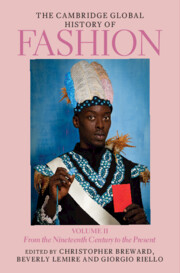Book contents
- The Cambridge Global History of Fashion
- The Cambridge Global History of Fashion
- The Cambridge Global History of Fashion
- Copyright page
- Contents for Volume II
- Figures for Volume II
- Maps for Volume II
- Table for Volume II
- Contributors for Volume II
- Preface
- Part IV Fashion, Modernism, and Modernity
- 21 Fashionable Masculinities in England and Beyond
- 22 Fashion in Capitalism
- 23 Fashion and Youth in Western Societies
- 24 Fashion and Time in China’s Twentieth Century
- 25 The Totalitarian State and Fashion in the Twentieth Century
- 26 Hollywood and Beyond
- 27 Fashion and Non-Fashion Cultures
- 28 Fashion and Hypermodernity
- Part V Fashion, Colonialism, and Post-Colonialism
- Part VI Fashion Systems and Globalization
- Index
- References
24 - Fashion and Time in China’s Twentieth Century
from Part IV - Fashion, Modernism, and Modernity
Published online by Cambridge University Press: 04 August 2023
- The Cambridge Global History of Fashion
- The Cambridge Global History of Fashion
- The Cambridge Global History of Fashion
- Copyright page
- Contents for Volume II
- Figures for Volume II
- Maps for Volume II
- Table for Volume II
- Contributors for Volume II
- Preface
- Part IV Fashion, Modernism, and Modernity
- 21 Fashionable Masculinities in England and Beyond
- 22 Fashion in Capitalism
- 23 Fashion and Youth in Western Societies
- 24 Fashion and Time in China’s Twentieth Century
- 25 The Totalitarian State and Fashion in the Twentieth Century
- 26 Hollywood and Beyond
- 27 Fashion and Non-Fashion Cultures
- 28 Fashion and Hypermodernity
- Part V Fashion, Colonialism, and Post-Colonialism
- Part VI Fashion Systems and Globalization
- Index
- References
Summary
In the year 2020, a pandemic traceable to a virus-rich species of horseshoe bat brought fashion weeks around the world to a halt. China was ground zero. With Hubei province in lockdown from late January and international borders soon closed to flights from anywhere in the country, few Chinese designers were able to attend the autumn/winter fashion weeks of February 2020. In Milan, hub of a Chinese regional cluster specializing in fashion, the Italian Fashion Chamber launched a ‘China we are with you’ campaign and compensated for the absence of Chinese designers with a virtual display of their works. In Paris a week later, the only show from China was a gallery display by Uma Wang. Facemasks were the accessory of the day. Soon fashion workshops all over the world would be churning them out.
- Type
- Chapter
- Information
- The Cambridge Global History of FashionFrom the Nineteenth Century to the Present, pp. 838 - 889Publisher: Cambridge University PressPrint publication year: 2023



